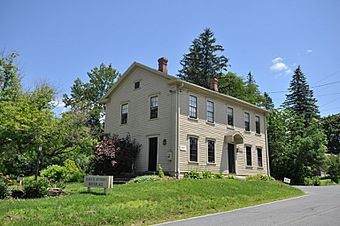Susan B. Anthony Birthplace Museum facts for kids
Quick facts for kids |
|
|
Susan B. Anthony Birthplace Museum
|
|
 |
|
| Location | Adams, Massachusetts |
|---|---|
| Built | 1817 |
| Architect | Anthony, Daniel |
| Architectural style | Federal |
| NRHP reference No. | 85000021 |
| Added to NRHP | January 3, 1985 |
The Susan B. Anthony Birthplace Museum is a special historic house museum in Adams, Massachusetts. It is famous because Susan B. Anthony, a leader in the fight for women's right to vote, was born here in 1820. The house is also important for its connection to early teachers and business owners in Adams. This historic home was added to the National Register of Historic Places in 1985.
Today, the house is a learning center and museum. It teaches visitors about Susan B. Anthony's early life. One part of the museum also shows her later work as an activist.
Contents
Exploring the Historic House
This house was built in 1817. It is a traditional 2.5-story colonial home. It has a central hallway and follows the Federalist style of architecture. Two chimneys rise from the middle of the building. A smaller 1.5-story section was added to the back of the house. A porch was added in the 1950s and later enclosed in the 1960s.
The original barn on the property was replaced by a modern garage. This garage now holds the museum's gift shop. Inside the house, the original layout is still there. A central hall has large public rooms at the front. Smaller service rooms are located at the back. The rear section has two small rooms. Most of the original wooden details have been kept.
What You Can See at the Museum
The museum shows what daily family life was like for the Anthonys in the early 1800s. It also highlights how their Quaker beliefs influenced Susan. The museum was restored between 2006 and 2009. It has both permanent and changing exhibits. You can visit rooms like the Kitchen and Hearth, Daniel Anthony's Store, the Birthing Room, the Portrait Gallery, and the Legacy Room.
Kitchen and Hearth
The Kitchen and Hearth was the main gathering place for the Anthony family. About 23 girls who worked in Daniel Anthony's mill also lived here. The mill was located across the road.
Daniel Anthony's Store
Daniel Anthony's store has been recreated to look like it did in 1817. Susan's father ran this store from the northeast room of their home. He sold supplies to his textile workers and neighbors.
The Birthing Room
The Birthing Room is where the first five of the Anthony children were born. This includes Susan B. Anthony herself.
Portrait Gallery
The Portrait Gallery displays pictures of members of the Anthony family. It also shows images of their friends.
Legacy Room
The Legacy Room has a timeline of Susan B. Anthony's life from 1820 to 1906. It also shows important world events from that time. This room has a collection of old items from her era. You can also see things like postcards and meeting notices. These items show the important issues early feminists cared about.
- Abolitionism: Susan B. Anthony grew up in a Quaker family that was against slavery. Slavery was a huge moral issue in the mid-1800s. It even led to the American Civil War. Anthony fought against slavery when she was younger.
- Temperance movement: Anthony became very involved in the temperance movement. This movement worked to reduce or stop the use of alcohol. Through this work, she saw that women had little power in politics. This led her to believe that women needed the right to vote.
- Suffrage: After the Civil War, Anthony dedicated her life to women's suffrage. This means fighting for women's right to vote. Others continued her work after she passed away. The 19th Amendment was passed in 1920. This amendment finally gave women the right to vote in the United States.
History of the Anthony Home
The first Anthony family member to arrive in Adams, Massachusetts, was David Anthony. He was Susan B. Anthony's great-grandfather. He came to the area before the American Revolutionary War. Many Quaker families moved here from Rhode Island. David started a cider mill that is still owned by the Anthony family today.
His grandson, also named David Anthony, built this house in 1817. It was a gift for his son, Daniel Anthony, who was Susan B. Anthony's father. David was a strong supporter of education. He taught at the East Road School. He also helped found the Adams Academy in 1825 with other Quakers. Daniel Anthony continued the family's interest in mills. He opened a cotton yarn mill in 1822.
Susan B. Anthony, Daniel's second child, was born in this house on February 15, 1820. In 1827, Daniel moved his family to Battenville, New York, for business reasons.
The house stayed in the Anthony family until 1895. After that, it had several different owners. The Society of Friends Descendants bought the property in 1926. They opened it as a museum. The building returned to private ownership in 1949. It was carefully restored between 2006 and 2009. Now, it is home to the nonprofit Susan B. Anthony Birthplace Museum. It shares the story of Susan B. Anthony's early life. It also highlights her important work for women's right to vote.



